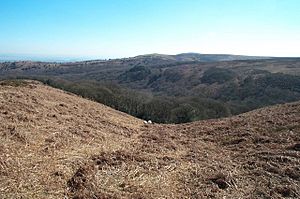Black Ball Camp facts for kids
Quick facts for kids Black Ball Camp |
|
|---|---|

Black Ball Hill
|
|
| Location | Dunster, Somerset, England |
| Area | 0.3 hectares (0.74 acres) |
| Built | Iron Age |
| Official name: Black Ball Camp | |
| Reference no. | 36857 |
| Lua error in Module:Location_map at line 420: attempt to index field 'wikibase' (a nil value). | |
Black Ball Camp is an ancient site from the Iron Age in Somerset, England. It's a type of old fort called a hill fort, built on top of a hill. You can find it southwest of a town called Dunster, on the northern part of Gallox Hill.
This special place is protected as a Scheduled Ancient Monument. This means it's an important historical site that must be preserved.
What is Black Ball Camp?
Black Ball Camp is also known as British Camp. Some people think it might be connected to another nearby site called Bat's Castle.
This hill fort has a large earth wall, or rampart, which is about 3 meters (10 feet) high. It also has a deep ditch, about 2 meters (7 feet) deep. These features were built to protect the people living inside. Long ago, at the start of the 1900s, people could see the remains of a stone tower here, but it's not there anymore.
Why Were Hill Forts Built?
Hill forts like Black Ball Camp were built a very long time ago, during the Late Bronze Age and Early Iron Age. This was around 3,000 years ago!
Historians and archaeologists have different ideas about why these forts were made:
- For Protection: Some think they were built as military bases to defend against attacks from other groups or invaders.
- Safe Homes: Others believe they were safe places for communities to live, especially when there was conflict or tension between different groups of people.
- Changing Times: During the Iron Age, people started using iron instead of bronze. This changed how people traded and lived. New leaders and groups became powerful, and hill forts might have been a way for these new groups to show their strength and protect their communities.
Even though these forts offered defense, they weren't always built because of constant war. They were more like strongholds that could be used when needed. Sometimes, these forts were attacked, but that wasn't the only reason they were built. They were also important centers for communities during a time of big changes.

